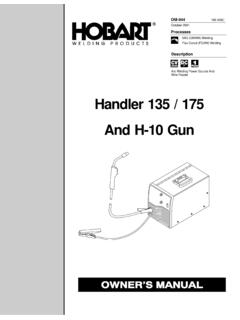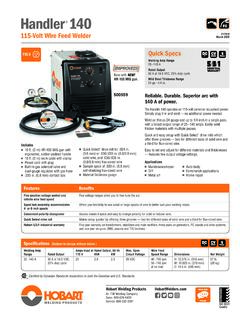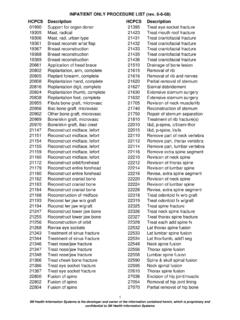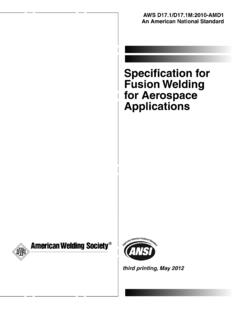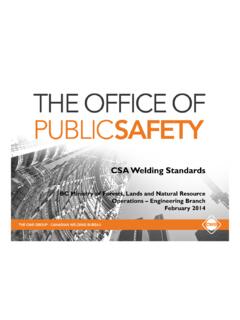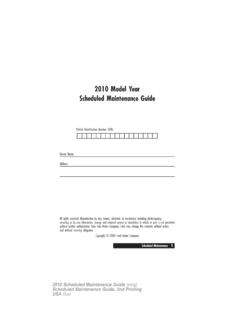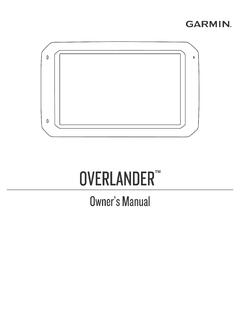Transcription of Handler 140 And H-10 Gun
1 ProcessesOM-925217 694C2006 10 Handler 140 And H-10 GunArc Welding Power Source AndWire FeederDescriptionMIG (GMAW) WeldingFlux Cored (FCAW) WeldingRHobart Welders manufactures a full lineof welders and welding related information on other quality Hobart products, contact your local Hobartdistributor to receive the latest full line catalog or individual specification locate your nearest distributor or service agency call 1-877-Hobart1 orvisit our website at Technical Help call you and congratulations on choosing Hobart. Now you can get thejob done and get it done right. We know you don t have time to do it anyother owner s Manual is designed to help you get the most out of yourHobart products. Please take time to read the Safety precautions. Theywill help you protect yourself against potential hazards on the ve made installation and operation quickand easy. With Hobart you can count on yearsof reliable service with proper if for some reason the unit needs repair,there s a Troubleshooting section that will helpyou figure out what the problem is.
2 The partslist will then help you to decide the exact partyou may need to fix the problem. Warranty andservice information for your particular modelare also is registered to theISO 9001:2000 QualitySystem as hard as youdo every power sourcefrom Hobart is backed bythe best warranty in Hobart to YouHob_Thank 2005 06 Register your product Your Investment!TABLE OF CONTENTSSECTION 1 SAFETY PRECAUTIONS - READ BEFORE USING1 .. Usage1 .. 1-2. Arc Welding Hazards1 .. Symbols For Installation, Operation, And Maintenance3 .. Proposition 65 Warnings3 .. Safety Standards4 .. Information4 .. SECTION 2 CONSIGNES DE S CURIT LIRE AVANT UTILISATION5 .. utilis s5 .. relatifs au soudage l arc5 .. suppl mentaires en relation avec l installation, le fonctionnement et la maintenance7 .. californienne 65 Avertissements7 .. normes de s curit 8 .. EMF8 .. SECTION 3 DEFINITIONS9 .. And Definitions9 .. SECTION 4 SPECIFICATIONS9 .. 4-1. Specifications9.
3 4-2. Duty Cycle And Overheating10 .. 4-3. Volt-Ampere Curves11 .. SECTION 5 INSTALLATION12 .. Welding Gun12 .. Work Clamp12 .. 5-3. Process/Polarity Table13 .. Polarity13 .. Gas Supply14 .. A Location And Connecting Input Power15 .. Wire Spool And Adjusting Hub Tension16 .. Contact Tip And Nozzle17 .. Welding Wire18 .. SECTION 6 OPERATION19 .. 6-1. Controls19 .. 6-2. Weld Parameter Chart20 .. SECTION 7 MAINTENANCE &TROUBLESHOOTING22 .. Maintenance22 .. Protection22 .. Motor Protection22 .. Drive Roll Or Wire Inlet Guide23 .. Gun Contact Tip23 .. Or Replacing Gun Liner24 .. Switch And/Or Head Tube25 .. 7-8. Troubleshooting Table26 .. SECTION 8 ELECTRICAL DIAGRAM27 .. TABLE OF CONTENTSSECTION 9 MIG WELDING (GMAW) GUIDELINES28 .. 9-1. Typical MIG Process Connections28 .. 9-2. Typical MIG Process Control Settings29 .. And Positioning Welding Gun30 .. That Affect Weld Bead Shape31 .. Movement During Welding32.
4 Weld Bead Characteristics32 .. Weld Bead Characteristics32 .. 9-8. Troubleshooting Excessive Spatter33 .. 9-9. Troubleshooting Porosity33 .. 9-10. Troubleshooting Excessive Penetration33 .. 9-11. Troubleshooting Lack Of Penetration34 .. 9-12. Troubleshooting Incomplete Fusion34 .. 9-13. Troubleshooting Burn-Through34 .. 9-14. Troubleshooting Waviness Of Bead35 .. 9-15. Troubleshooting Distortion35 .. MIG Shielding Gases36 .. 9-17. Troubleshooting Guide For Semiautomatic Welding Equipment36 .. SECTION 10 PARTS LIST38 .. WARRANTYOM-925 Page 1 SECTION 1 SAFETY PRECAUTIONS - READ BEFORE USINGsom _3/05 YWarning: Protect yourself and others from injury read and follow these Symbol UsageMeans Warning! Watch Out! There are possible hazardswith this procedure! The possible hazards are shown inthe adjoining a special safety Note ; not safety group of symbols means Warning! Watch Out! possibleELECTRIC SHOCK, MOVING PARTS, and HOT PARTS symbols and related instructions below for necessary actionsto avoid the Arc Welding HazardsYThe symbols shown below are used throughout this manual tocall attention to and identify possible hazards.
5 When you seethe symbol, watch out, and follow the related instructions toavoid the hazard. The safety information given below is onlya summary of the more complete safety information found inthe Safety Standards listed in Section 1-5. Read and follow allSafety qualified persons should install, operate, maintain, andrepair this operation, keep everybody, especially children, SHOCK can live electrical parts can cause fatal shocksor severe burns. The electrode and work circuit iselectrically live whenever the output is on. The inputpower circuit and machine internal circuits are alsolive when power is on. In semiautomatic or automatic wire welding, thewire, wire reel, drive roll housing, and all metal parts touching thewelding wire are electrically live. Incorrectly installed or improperlygrounded equipment is a not touch live electrical dry, hole-free insulating gloves and body yourself from work and ground using dry insulating matsor covers big enough to prevent any physical contact with the workor not use AC output in damp areas, if movement is confined, or ifthere is a danger of AC output ONLY if required for the welding AC output is required, use remote output control if present safety precautions are required when any of the follow-ing electrically hazardous conditions are present: in damplocations or while wearing wet clothing; on metal structures suchas floors, gratings, or scaffolds; when in cramped positions suchas sitting, kneeling, or lying; or when there is a high risk of unavoid-able or accidental contact with the workpiece or ground.
6 For theseconditions, use the following equipment in order presented: 1) asemiautomatic DC constant voltage (wire) welder, 2) a DC manual(stick) welder, or 3) an AC welder with reduced open-circuit volt-age. In most situations, use of a DC, constant voltage wire welderis recommended. And, do not work alone!DDisconnect input power or stop engine before installing orservicing this equipment. Lockout/tagout input power according toOSHA 29 CFR (see Safety Standards).DProperly install and ground this equipment according to itsOwner s Manual and national, state, and local verify the supply ground check and be sure that inputpower cord ground wire is properly connected to ground terminal indisconnect box or that cord plug is connected to a properlygrounded receptacle making input connections, attach proper grounding conduc-tor first double-check inspect input power cord for damage or bare wiring replace cord immediately if damaged bare wiring can off all equipment when not in not use worn, damaged, undersized, or poorly spliced not drape cables over your earth grounding of the workpiece is required, ground it directlywith a separate not touch electrode if you are in contact with the work, ground,or another electrode from a different not touch electrode holders connected to two welding ma-chines at the same time since double open-circuit voltage will only well-maintained equipment.
7 Repair or replace damagedparts at once. Maintain unit according to a safety harness if working above floor all panels and covers securely in work cable with good metal-to-metal contact to workpieceor worktable as near the weld as work clamp when not connected to workpiece to preventcontact with any metal not connect more than one electrode or work cable to anysingle weld output DC VOLTAGE exists in inverter-typewelding power sources after removal of Off inverter, disconnect input power, and discharge inputcapacitors according to instructions in Maintenance Sectionbefore touching any produces fumes and gases. Breathingthese fumes and gases can be hazardous to AND GASES can be your head out of the fumes. Do not breathe the inside, ventilate the area and/or use local forced ventilation at thearc to remove welding fumes and ventilation is poor, wear an approved air-supplied and understand the Material Safety Data Sheets (MSDSs)and the manufacturer s instructions for metals, consumables,coatings, cleaners, and in a confined space only if it is well ventilated, or whilewearing an air-supplied respirator.
8 Always have a trained watch-person nearby. Welding fumes and gases can displace air andlower the oxygen level causing injury or death. Be sure the breath-ing air is not weld in locations near degreasing, cleaning, or spraying op-erations. The heat and rays of the arc can react with vapors to formhighly toxic and irritating not weld on coated metals, such as galvanized, lead, orcadmium plated steel, unless the coating is removed from the weldarea, the area is well ventilated, and while wearing an air-suppliedrespirator. The coatings and any metals containing these elementscan give off toxic fumes if Page 2 Arc rays from the welding process produce intensevisible and invisible (ultraviolet and infrared) raysthat can burn eyes and skin. Sparks fly off from RAYS can burn eyes and an approved welding helmet fitted with a proper shade of fil-ter lenses to protect your face and eyes when welding or watching(see ANSI and listed in Safety Standards).DWear approved safety glasses with side shields under protective screens or barriers to protect others from flash,glare and sparks; warn others not to watch the protective clothing made from durable, flame-resistant mate-rial (leather, heavy cotton, or wool) and foot on closed containers, such as tanks,drums, or pipes, can cause them to blow up.
9 Sparkscan fly off from the welding arc. The flying sparks, hotworkpiece, and hot equipment can cause fires andburns. Accidental contact of electrode to metal objects can causesparks, explosion, overheating, or fire. Check and be sure the area issafe before doing any can cause fire or all flammables within 35 ft ( m) of the welding arc. Ifthis is not possible, tightly cover them with approved not weld where flying sparks can strike flammable yourself and others from flying sparks and hot alert that welding sparks and hot materials from welding caneasily go through small cracks and openings to adjacent for fire, and keep a fire extinguisher aware that welding on a ceiling, floor, bulkhead, or partition cancause fire on the hidden not weld on closed containers such as tanks, drums, or pipes,unless they are properly prepared according to AWS (seeSafety Standards).DConnect work cable to the work as close to the welding area aspractical to prevent welding current from traveling long, possiblyunknown paths and causing electric shock, sparks, and not use welder to thaw frozen stick electrode from holder or cut off welding wire atcontact tip when not in oil-free protective garments such as leather gloves, heavyshirt, cuffless trousers, high shoes, and a any combustibles, such as a butane lighter or matches,from your person before doing any requirements in OSHA (a) (2) (iv) and NFPA 51 Bfor hot work and have a fire watcher and extinguisher METAL can injure , chipping, wire brushing, and grindingcause sparks and flying metal.
10 As welds cool,they can throw off approved safety glasses with sideshields even under your welding OF GAS can injure or off shielding gas supply when not in ventilate confined spaces or useapproved air-supplied PARTS can cause severe not touch hot parts bare cooling period before working on gun handle hot parts, use proper tools and/orwear heavy, insulated welding gloves andclothing to prevent FIELDS can affect wearers keep should consult their doctor beforegoing near arc welding, gouging, or spotwelding can damage from some processes or equipment candamage approved ear protection if noise level gas cylinders contain gas under highpressure. If damaged, a cylinder can explode. Sincegas cylinders are normally part of the weldingprocess, be sure to treat them can explode if compressed gas cylinders from excessive heat, mechani-cal shocks, physical damage, slag, open flames, sparks, and cylinders in an upright position by securing to a stationarysupport or cylinder rack to prevent falling or cylinders away from any welding or other electrical drape a welding torch over a gas allow a welding electrode to touch any weld on a pressurized cylinder explosion will only correct shielding gas cylinders, regulators, hoses, and fit-tings designed for the specific application.
